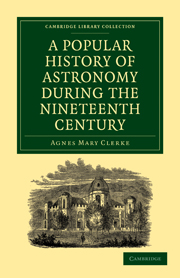Book contents
- Frontmatter
- PREFACE
- Contents
- INTRODUCTION
- Part I PROGRESS OF ASTRONOMY DURING THE FIRST HALF OF THE NINETEENTH CENTURY
- Part II RECENT PROGRESS OF ASTRONOMY
- CHAPTER I FOUNDATION OF ASTRONOMICAL PHYSICS
- CHAPTER II SOLAR OBSERVATIONS AND THEORIES
- CHAPTER III RECENT SOLAR ECLIPSES
- CHAPTER IV SPECTROSCOPIC WORK ON THE SUN
- CHAPTER V TEMPERATURE OF THE SUN
- CHAPTER VI THE SUN'S DISTANCE
- CHAPTER VII PLANETS AND SATELLITES
- CHAPTER VIII PLANETS AND SATELLITES (continued)
- CHAPTER IX THEORIES OF PLANETARY EVOLUTION
- CHAPTER X RECENT COMETS
- CHAPTER XI RECENT COMETS (continued)
- CHAPTER XII STARS AND NEBULÆ
- CHAPTER XIII METHODS OF RESEARCH
- INDEX
CHAPTER III - RECENT SOLAR ECLIPSES
Published online by Cambridge University Press: 07 September 2011
- Frontmatter
- PREFACE
- Contents
- INTRODUCTION
- Part I PROGRESS OF ASTRONOMY DURING THE FIRST HALF OF THE NINETEENTH CENTURY
- Part II RECENT PROGRESS OF ASTRONOMY
- CHAPTER I FOUNDATION OF ASTRONOMICAL PHYSICS
- CHAPTER II SOLAR OBSERVATIONS AND THEORIES
- CHAPTER III RECENT SOLAR ECLIPSES
- CHAPTER IV SPECTROSCOPIC WORK ON THE SUN
- CHAPTER V TEMPERATURE OF THE SUN
- CHAPTER VI THE SUN'S DISTANCE
- CHAPTER VII PLANETS AND SATELLITES
- CHAPTER VIII PLANETS AND SATELLITES (continued)
- CHAPTER IX THEORIES OF PLANETARY EVOLUTION
- CHAPTER X RECENT COMETS
- CHAPTER XI RECENT COMETS (continued)
- CHAPTER XII STARS AND NEBULÆ
- CHAPTER XIII METHODS OF RESEARCH
- INDEX
Summary
By observations made during a series of five remarkable eclipses, comprised within a period of eleven years, knowledge of the solar surroundings was advanced nearly to its present stage. Each of these events brought with it a fresh disclosure of a definite and unmistakable character. We will now briefly review this orderly sequence of discovery.
Photography was first systematically applied to solve the problems presented by the eclipsed sun, July 18, 1860. It is true that a very creditable daguerreotype, taken by Busch at Königsberg during the eclipse of 1851, is still valuable as a record of the corona of that year; and some subsequent attempts were made to register partial phases of solar occultation; but the ground remained practically unbroken until 1860.
In that year the track of totality crossed Spain, and thither, accordingly, Mr. Warren De la Rue transported his photo-heliograph, and Father Secchi his six-inch Cauchoix refractor. The question then primarily at issue was that relating to the nature of the red protuberances. Although, as already stated, the evidence collected in 1851 gave a reasonable certainty of their connection with the sun, objectors were not silenced; and when the side of incredulity was supported by so considerable an authority as M. Faye, it was impossible to treat it with contempt. Two crucial tests were available.
- Type
- Chapter
- Information
- A Popular History of Astronomy During the Nineteenth Century , pp. 213 - 237Publisher: Cambridge University PressPrint publication year: 2010First published in: 1885



